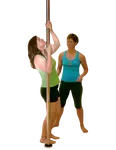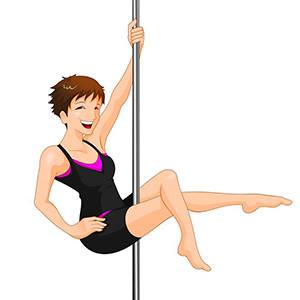- Home
- FAQ
- Pole Safety FAQ
- Platform Dance Pole Safety
- Home
- Pole Gear
- Dance Poles
- Platform Dance Pole Info
- Platform Dance Pole Safety
Platform Dance Pole Safety
A platform dance pole allows you to practice or perform almost anywhere. While not the only type of pole that opens up more location possibilities, a platform pole is definitely one of the most versatile. But it also comes with its own set of unique safety issues to manage. On this page, you'll learn all there is to know about platform dance pole safety. Let's get started!
This page may contain affiliate links. If you make a purchase through one of these links, Your Pole Pal may receive a small commission (at no cost to you). And that helps ensure this site stays online and free for everyone. Learn more.
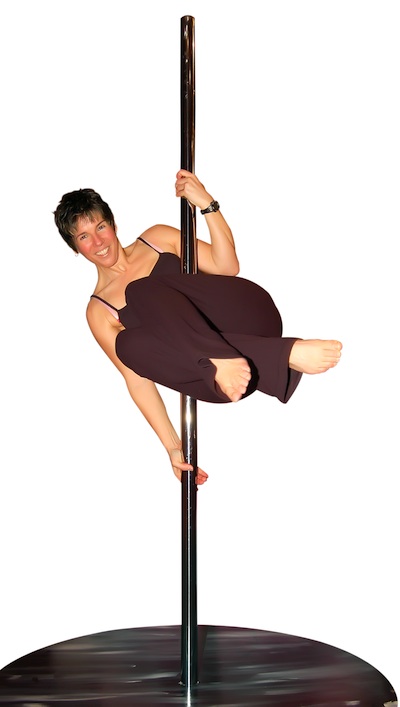
Table of Contents
Here's what you'll find on this page:
Main Points for Platform Dance Pole Safety
Here are the basics of what you need to know to stay safe if you're considering a platform dance pole. You'll find additional details a bit further
down this page.
- Falls can be more of a concern than normal due to the fact that the platform is often raised some distance off the ground.
- You'll need to be aware of how much "stage area" your pole's platform provides so you don't injure yourself on the edges of the platform, or misjudge how much space you have to land a trick.
- Stability has improved a lot in recent years, but you still need to remember that your pole is affixed to a base that can lift in certain situations. Some models have options to add weight to the base, which is something to consider for maximum platform dance pole safety.
- Transporting and assembling a platform pole often involves managing several cases and quite a few parts. Keeping track of all the components is important, since if you lose something your pole may not be safe to use.
Your Pole Pal has often used a platform dance pole for demos, performances, and at trade shows and exhibitions where installing a friction fit pole isn't feasible. These types of situations are where the flexibility of a platform pole really shines, but changing between a regular pole (ie one that is installed from floor to ceiling) and a platform pole requires good spacial awareness, mental flexibility, and the ability to quickly adapt to a new scenario in order to maintain a safe environment for pole dancing.
The points above, and the more detailed information that follows won't guarantee you'll always be 100% safe when using your platform dance pole, but they can help you understand some of the nuances of platform dance pole safety and how to reduce your chances for injury.
Understanding Platform Dance Pole Safety
A platform dance pole is a unique setup, and therefore the safety issues to be aware of are also unique to this type of pole. Let's take a look in more detail at the 4 main safety points mentioned above. These can be summed up as follows: height from the ground; dance-able area; stability of the platform base; and a greater number of parts to keep track of.
Height From the Ground
While the platform base of this type of pole will vary in height according to the manufacturer and the option chosen, some have a fairly tall base which increases how high you are off the ground when you're up on your pole.
The two images below show the difference between a lower profile platform and one that's higher off the ground.
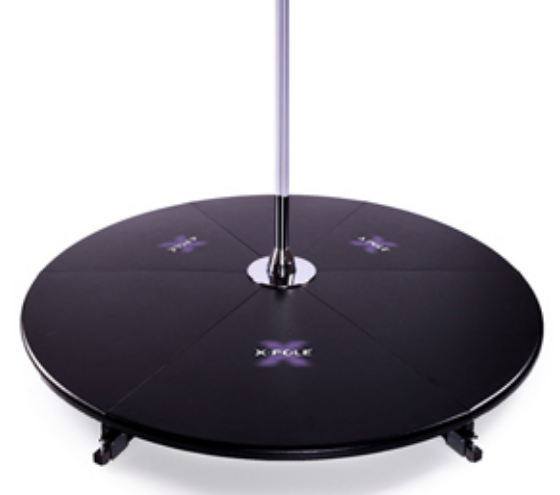 The X-Pole Lite has a base height of only 4" (10 cm)
The X-Pole Lite has a base height of only 4" (10 cm)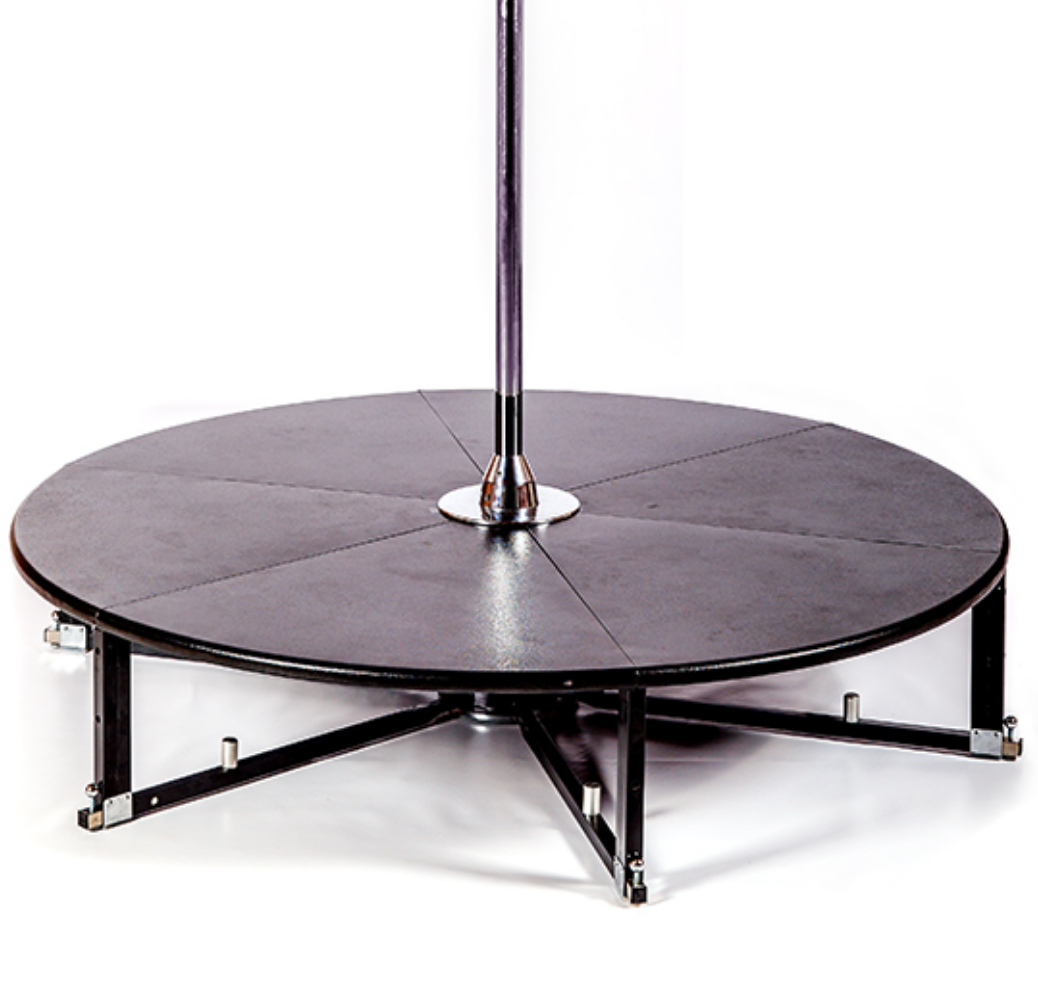 The Standard X-Stage has a base that's 12" (30 cm) high
The Standard X-Stage has a base that's 12" (30 cm) highIt's easy to overlook the extra height of some platforms because in theory the base becomes the new "ground" when using a platform pole.
However, consider that if you slip and suffer a fall from your platform dance pole, you may not have the control to be able to land entirely on the base. Essentially, you'll be adding the height of the pole base to the distance you could potentially fall.
And while any fall is bad news, obviously the farther you fall the worse things can be.
While this is not a reason NOT to use a platform dance pole, it's something to be taken into consideration when deciding if a platform pole is the right choice for you in a given situation.
If you're a beginner for example, you may feel safer learning on a pole that is not elevated off the ground, or on a platform pole with a lower base height. If you're a more advanced pole dancer giving a demo or a performance, you may want to assess which tricks you'll use in your routine according to how confident you feel about doing them on a platform dance pole, especially one that's higher off the ground.
Dance-able Area
The dance-able area of a platform pole refers to the size of the platform base. Compared to a more traditional pole that rests on the floor, you'll have limited floor area around the pole when dancing on a platform. This will limit your ability to do floorwork, but more importantly from a safety perspective, it requires greater awareness when landing a trick.
With a platform pole, you need to know the diameter of your pole base and be able to translate that into safe landings. You want to land your tricks solidly on the base, not on the ground, which could be up to 12" (30 cm) below the base.
But you also need to be aware of those edges! Landing on the ground is one thing, but landing a trick part way between the platform and the ground (i.e. against the edge of your platform base) is another thing entirely.
And it's not just upright landings that we need to be concerned about. Those can be hard enough to control, but have you ever been upside down on your pole and felt yourself slipping?
In fact, Your Pole Pal once lost her grip while inverted on her platform pole and even though the slide to the ground was only a short distance, and the descent was fairly controlled, guess who managed to break a bone in her foot?
Yes that's right, in an attempt to avoid landing directly on her head, Your Pole Pal swung her leg off the pole to get into a more horizontal position, and promptly smacked the outside of her foot on the edge of the platform base. Ouch!
The good news is that the injury was limited to one foot. Unfortunately there is nothing that can be done about a broken bone in that particular location except wait for it to heal, which took a very long time and was painful enough to keep Your Pole Pal off her dance pole for a fair while.
Fortunately, crash mats made specifically for platform poles are now available, whereas back in the day there was much less awareness around the need for platform dance pole safety equipment like mats. A crash mat will not only help to cushion a fall onto your platform base, it also offers some protection against those nasty "edged-based injuries."
For maximum safety, Your Pole Pal strongly suggests that all polers use a pole dance crash mat, no matter which type of pole you use.
Stability of the Platform Base
Obviously, platform dance poles are not secured to a ceiling or other stabilizing fixture at the top. While this is what makes these poles so flexible (no ceiling? no problem!), this feature is also what contributes to a potential lack of stability.
Instead of a ceiling fixture, platform dance poles rely on a sufficiently stable base to keep the pole upright and secure. In other words, with a platform pole, the worry is not about the pole coming down, but about the base lifting and potentially tipping over.
Fortunately, manufacturers have been coming up with various ways to increase the stability of their platform poles for some time now.
Adding weights to the base was the first innovation, and some platform poles still allow for this option. Typically weight plates or sandbags are placed under the platform, on its "legs" or brackets. Adding this extra weight to the base acts as ballast, helping to counter the weight of the pole dancer. This in turn increases stability and reduces the chance of the base lifting or tipping.
More recently, platform dance poles have been designed with extensions on the "legs" of the pole base. Basic physics says that the larger the base, the more stable the platform will be. But it's not practical to have a base that's too large, and the cost would have to increase quite a lot as well to account for the extra material needed to make a larger platform.
The answer is to keep the stage area of the platform base the same size, but increase its stability by adding horizontal legs that increase the effective size of the base. Some platform poles have legs of a fixed length, while others have adjustable legs. If you're considering a pole with fixed length legs, you may want to consider using weights as well, for exta stability.
The short 1 minute video below demonstrates how the adjustable leg mechanism works on the X-Stage, X-Pole's branded platform dance pole.

Of course, it's preferable from a platform dance pole safety perspective to use either weights or extensions to increase the stability of the base. If this is not possible, it's extra important to use caution and stay aware as you learn about how your particular platform reacts to the laws of physics.
You will probably experience some lifting of the base if it's unweighted/unstabilized, but with practice you can learn to control your momentum and keep it within safe limits so that lifting is minimized.
When using a platform pole the first few times, try to take things easy until you get your bearings. You'll need to understand how stable the base is, how it responds to spins and other tricks, and how your comfort level fits into the picture. For this reason, it's advisable to start with easier spins and tricks and gradually work your way up, so you can experience how the base of your pole responds.
Keeping Track of Parts
While keeping track of parts might not make the top of the list as a platform dance pole safety issue, keep in mind that the more parts your pole has, the more you'll have to manage and the greater the possibility that something could go missing. And if that happens, it will be more than an inconvenience, since each piece is important in creating a safe assembly for your platform pole.
Due to the size of the platform base, most platform poles today are made to be broken down into a series of panels which form the stage area. In addition, you'll have the supports or "legs" of the base to account for, the housing the pole fits into, and likely assorted pieces of hardware and possibly a specialized tool or two.
Fortunately, platform poles generally come with one or more carrying cases to help you manage all those pieces. While this helps with transporting, it's also important to always double check that all the parts are in their proper place inside their cases, both when packing up and unpacking your pole.
Taking an extra minute to run through a checklist of parts as you pack up is a wise investment of time. If your platform pole didn't come with such a list, Your Pole Pal suggests you make your own.
It can be as simple as a piece of paper that lists each component and how many of each there should be. Keep this list, along with a pencil, in one of your cases, and check off each item as you pack up your pole. Better yet, create a note on your phone and turn it into a checklist. That way you won't even have to remember to pack your paper and pencil!
Safe Assembly & Use of Your Platform Dance Pole
Correct assembly is important with any type dance pole of course, but with a platform pole there are a few extra considerations to take into account.
First, ensure the area where you're going to set up your platform pole is as level as possible. If you're setting up outdoors, be aware that the chances are greater that the surface may be uneven so leave yourself extra time to make adjustments if necessary.
Some platform poles come equipped with adjustable feet (different from the adjustable legs that increase stability) that can be raised or lowered as necessary to level the base, but these can only do so much. Placing your platform base in a location that's as level as possible will get you off to a safe start when setting up.
You'll also want to make sure there is sufficient space around the base of your pole that you can perform the tricks you have in mind without running into objects like trees, furniture, vehicles, or observers.
Give yourself a buffer zone a little bigger than you think you'll need and mark it off. Observers tend to assume that they can safely come right up to the edge of the platform, not realizing that some tricks can extend beyond that area, or that your "fall zone" may be greater than just the area of the platform base.
The platform or stage area of the pole is more than just a dance surface; it's also responsible for holding your pole securely in place, so take care with assembling the base and the fixture into which the pole is inserted. Make sure all the parts are tightened per the manufacturer's instructions, and be sure you test all the connections, bolts and fasteners thoroughly to be sure they're tight and secure before you start dancing. You may also want to use weights or extendable legs as discussed above, for maximum safety.
Once assembled, do some graduated test spins to ensure the pole base is stable. If you feel like anything is a bit "off" or you're uncomfortable doing any of your usual moves, double check to make sure everything has been assembled correctly. If necessary, enlist help to move the platform to a more stable spot, and/or place some stabilizing material under the pole base.
Another important platform dance pole safety consideration that applies especially to those who have a homemade platform base, is being able to move the base from place to place safely.
Many homemade bases are made of wood and are permanently assembled into one piece. These pole bases can be heavy and somewhat awkward to move. If you have one of these types of platforms, you'll want to make sure you have at least one helper when moving and loading it into your vehicle.
Remember to use basic lifting safety...use your knees, not your back, and make sure you have enough help so that no one is lifting more than they can reasonably manage.
Platform Dance Pole Safety Recap
- Ensure your platform pole is assembled correctly and completely each time you use it.
- Depending on the style of your platform, you may wish to weight the base for extra security, or purchase a pole with extendable "legs" that will offer additional stability.
- If you have a raised platform on your model, be extra careful as falls can be that much more painful.
- Ensure you are fully aware of how much space you have available at the base of your pole in order to land your tricks safely.
- Allow for a sufficient buffer zone around your platform to account for tricks where your body may extend beyond the edges of the platform.
- Use a crash mat specifically designed to fit exactly over the base of your platform pole.
- All the parts required for assembly of your platform dance pole are important; keep a checklist to help ensure that all are accounted for each time you pack up your pole.
- If using a heavy, one-piece base, be sure you have enough help when moving it so no one gets injured.
Top Picks for Platform Dance Poles

X-Pole makes two very good platform poles that Your Pole Pal recommends.
The X-Stage is the original platform pole from X-Pole. This pole has a 12" (30 cm) high base that's 5' (1.5 m) in diameter.
The total assembled weight of the X-Stage is 233 lbs (106 kg), with the base weighing 85 lbs (38.5 kg). The parts fit into 4 carrying cases which come with the pole. This model has extendable legs for increased stability, and can also be used with weight plates or sandbags if desired. The danceable area on the X-Stage is 9' (2.75 m) and the pole can be converted from static to spin mode.
The X-Stage Lite is X-Pole's other option for a platform dance pole. It has a lower profile base that's just 4" (10 cm) high but the diameter is the same as the standard model at 5' (1.5 m). The base weighs 20 lbs (9 kg) less than the original X-Stage, and the total setup weighs in at 213 lbs (96.5 kg).
While the X-Stage Lite does have adustable feet for leveling, it does NOT have the extendable legs that the X-Stage does. However, weight plates or sandbags can be used with this model as well.
Due to the lower podium height, there is more usable area on the pole itself, at 9.5' (2.9 m) and the pole itself can easily switch between static and spin modes.
Both models offer a wheeled carry case for the platform sections for easier transport, and both bases also have rounded edges for safety. The recommended weight limit for both models of platform pole is 330 lbs (150 kg).
More details about these two XPole platform dance poles can be found at X-Pole US (for those located in the USA, Canada and Mexico) or at X-Pole UK (for those located in all other countries).
Thinking of buying a platform dance pole? Be sure to check out this dance pole reviews page for detailed information on all the different brands of platform poles available.
What's New?
-
Find Colorado Pole Dancing Classes
Oct 31, 25 02:44 PM
Searching for Colorado pole dancing opportunities? Come on in and let us help you find a class near you with our free directory. -
Plus Size Dance Pole Guide - Top Poles with Higher Weight Limits
Jul 31, 25 03:03 PM
What's the best plus size dance pole? Not all poles are created equal. Find out which brands support higher weight limits, and which ones to avoid. -
Pole Dance Studios in Brazil | Global Pole Directory
Jul 26, 25 04:55 PM
Explore pole dance studios and instructors across Brazil. Find pole fitness classes for all levels and styles with the Brazil pole dancing directory. -
Pole Fitness in Hawaii | Worldwide Pole Dance Directory
Jul 14, 25 11:39 PM
Searching for pole fitness in Hawaii? Look no further! Discover pole studios and instructors across Hawaii and start your pole dance fitness adventure today! . -
London Pole Studios & More | Pole Dancing in England
Jul 13, 25 11:44 PM
Discover top pole studios in London as well as pole dancing classes throughout England. Find local studios near you to start your pole dancing adventure today.
Your Pole Pal loves to have fun, but she also has to earn a living, right? That's why you'll see ads on this site. She may also earn commissions on some of the products you'll see here, but there's never any cost to you since the advertisers pay for these.
The income generated through these means helps ensure Your Pole Pal can devote the time to providing you with all the free and fabulous information & resources you'll find on this website.
Want to learn more? Your Pole Pal invites to you read her full advertising disclosure. You know...in case you haven't read enough legalese lately.

